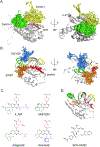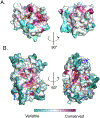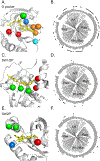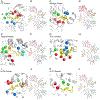Therapeutic Targeting the Allosteric Cysteinome of RAS and Kinase Families
- PMID: 35595166
- PMCID: PMC9590303
- DOI: 10.1016/j.jmb.2022.167626
Therapeutic Targeting the Allosteric Cysteinome of RAS and Kinase Families
Abstract
Allosteric mechanisms are pervasive in nature, but human-designed allosteric perturbagens are rare. The history of KRASG12C inhibitor development suggests that covalent chemistry may be a key to expanding the armamentarium of allosteric inhibitors. In that effort, irreversible targeting of a cysteine converted a non-deal allosteric binding pocket and low affinity ligands into a tractable drugging strategy. Here we examine the feasibility of expanding this approach to other allosteric pockets of RAS and kinase family members, given that both protein families are regulators of vital cellular processes that are often dysregulated in cancer and other human diseases. Moreover, these heavily studied families are the subject of numerous drug development campaigns that have resulted, sometimes serendipitously, in the discovery of allosteric inhibitors. We consequently conducted a comprehensive search for cysteines, a commonly targeted amino acid for covalent drugs, using AlphaFold-generated structures of those families. This new analysis presents potential opportunities for allosteric targeting of validated and understudied drug targets, with an emphasis on cancer therapy.
Keywords: KRAS inhibitor; allosteric inhibitor; covalent inhibitor; cysteinome; kinase inhibitor.
Copyright © 2022 Elsevier Ltd. All rights reserved.
Conflict of interest statement
Competing Interests Statement Kenneth Westover is a member of the Scientific Advisory Board for Vibliome Therapeutics and on the Advosory Panel for Reactive Biosciences. The Westover lab receives or has received research funding from Astellas and Revolution Medicines. None of these relationships are in conflict with the content of this manuscript.
Figures






Similar articles
-
Drugging K-RasG12C through covalent inhibitors: Mission possible?Pharmacol Ther. 2019 Oct;202:1-17. doi: 10.1016/j.pharmthera.2019.06.007. Epub 2019 Jun 22. Pharmacol Ther. 2019. PMID: 31233765 Review.
-
Selective Inhibition of Oncogenic KRAS Output with Small Molecules Targeting the Inactive State.Cancer Discov. 2016 Mar;6(3):316-29. doi: 10.1158/2159-8290.CD-15-1105. Epub 2016 Jan 6. Cancer Discov. 2016. PMID: 26739882
-
The Cysteinome of Protein Kinases as a Target in Drug Development.Angew Chem Int Ed Engl. 2018 Apr 9;57(16):4372-4385. doi: 10.1002/anie.201707875. Epub 2018 Feb 2. Angew Chem Int Ed Engl. 2018. PMID: 28994500 Review.
-
Developing irreversible inhibitors of the protein kinase cysteinome.Chem Biol. 2013 Feb 21;20(2):146-59. doi: 10.1016/j.chembiol.2012.12.006. Chem Biol. 2013. PMID: 23438744 Free PMC article. Review.
-
Small molecule kinase inhibitors as anti-cancer therapeutics.Mini Rev Med Chem. 2012 May;12(5):399-411. doi: 10.2174/138955712800493915. Mini Rev Med Chem. 2012. PMID: 22303944 Review.
Cited by
-
Computer-Aided Drug Design Boosts RAS Inhibitor Discovery.Molecules. 2022 Sep 5;27(17):5710. doi: 10.3390/molecules27175710. Molecules. 2022. PMID: 36080477 Free PMC article. Review.
-
Open-source electrophilic fragment screening platform to identify chemical starting points for UCHL1 covalent inhibitors.SLAS Discov. 2024 Dec;29(8):100198. doi: 10.1016/j.slasd.2024.100198. Epub 2024 Nov 30. SLAS Discov. 2024. PMID: 39622293 Free PMC article.
-
AlphaFold, Artificial Intelligence (AI), and Allostery.J Phys Chem B. 2022 Sep 1;126(34):6372-6383. doi: 10.1021/acs.jpcb.2c04346. Epub 2022 Aug 17. J Phys Chem B. 2022. PMID: 35976160 Free PMC article. Review.
-
The Construction of a Molecular Model for the Ternary Protein Complex of Intrinsic Coagulation Pathway Factors Provides Novel Insights for the Pathogenesis of Cross-Reactive Material Positive Coagulation Factor Mutations.Int J Mol Sci. 2025 May 28;26(11):5191. doi: 10.3390/ijms26115191. Int J Mol Sci. 2025. PMID: 40508000 Free PMC article.
-
Overexpression of Protein Kinase C iota as a prognostic marker and its role in oxaliplatin resistance in colorectal cancer.BMC Gastroenterol. 2025 Aug 12;25(1):580. doi: 10.1186/s12876-025-04153-x. BMC Gastroenterol. 2025. PMID: 40797188 Free PMC article.
References
-
- Lu S, Shen Q, Zhang J, (2019). Allosteric Methods and Their Applications: Facilitating the Discovery of Allosteric Drugs and the Investigation of Allosteric Mechanisms. Acc. Chem. Res 52, 492–500. - PubMed
-
- Attwood MM, Fabbro D, Sokolov AV, Knapp S, Schioth HB, (2021). Trends in kinase drug discovery: targets, indications and inhibitor design. Nat. Rev. Drug Discov 20, 839–861. - PubMed
Publication types
MeSH terms
Substances
Grants and funding
LinkOut - more resources
Full Text Sources
Medical
Miscellaneous

